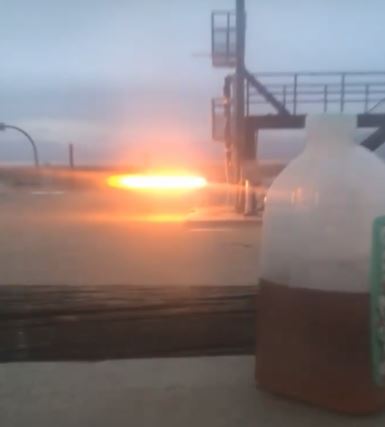by Dave Nordling, RRS.ORG
The Reaction Research Society (RRS) held a launch and static fire event for three UCLA teams and one of our own RRS teams at the Mojave Test Area (MTA) on Saturday, 2/22/2020. Poor weather was a persistent threat from the day before with light rains coming and going from the early morning hours and even throughout the launch day. Winds calmed just enough for a successful rail launch of UCLA’s solid rocket motor. Fortune favors the bold and this proverb did not disappoint our participants that day at the MTA.

With the liquid and hybrid rockets, Osvaldo Tarditti, our RRS president was our pyro-op in charge. I served as his apprentice for this event as part of building my experience for becoming a pyrotechnic operator 1st Class. This was the second of two apprenticeships I have served under two first class pyrotechnic operators. Osvaldo gave our safety briefing to all of our attendees that day before beginning the scheduled events.

UCLA had three projects ready for flight or static-fire at the MTA. The first was the solid motor driven rocket built by the UCLA Project Prometheus team. They were using a commercial K-sized motor with a vehicle equipped with a downward-facing camera built into the lower body.


Elizabeth, the UCLA team leader for this solid rocket project assisted me with the launch preparations. The rail launched rocket worked perfectly and the recovery system operation was visually confirmed as it descended to the west of our launch site.


Larry, Osvaldo and I have made progress on improving the 2-1/2 inch rocket with a commercial H-sized hybrid motor. Larry made an extension on the payload tube to fit all of the recovery system more easily. We have the Contrails H222 motor fully integrated and ready for loading.

Our nitrous bottle was refurbished and reloaded for the testing and we successfully conducted a valve test of the manifold that verified that our control box works well. We were reworking the black powder charge and repacking the parachute when the weather shifted and the winds picked up.

The weather was perfect 15 minutes earlier with the launch of UCLA’s solid motor, but at the time we were discussing launch of our hybrid motor it became clear the weather would be getting worse and winds too strong for launch of a smaller rocket such as ours. Since the RRS will be returning to the MTA site on Sunday, March 1. We figured we would do some minor improvements to the payload packaging and try again when we are fully confident and hopefully with better weather for the flight.


UCLA’s hybrid rocket team under the same name, Project Prometheus, sought to static fire a commercial M-sized hybrid motor as part of getting ready for a flight later this semester. They secured their test stand vertically to our historical I-beam location which was the original article from even before the RRS moved to the current MTA site in 1955. The RRS was glad to assist UCLA in securing to this location and making ready for nitrous oxide fill operations then ignition for static fire measurements.

Hot-fire of the hybrid motor took place around 5pm which by all appearances was a success. The motor case was intact and post-flight assessments looked promising, but an error in data acquisition resulted in no thrust measurements being recorded despite successes in pre-test checkout. UCLA is considering re-attempting this testing at the RRS MTA very soon.

The last of the three projects would be the static fire of the liquid rocket for Project Ares. The liquid rocket team mounted their hardware to the vertical test stand simultaneously as the hybrid rocket team mounted to the I-beam thrust stand. Both teams worked hard to be ready before the other but in the end, the liquid rocket took longer to be ready.
This would be a second attempt to static fire their liquid rocket system from 2/1/2020 at the RRS MTA. UCLA had been finding and fixing leaks in their pressurization system in the weeks leading before this test.

They proved their fixes before departing to the RRS MTA, but again ran into problems with leakage in the pressurant system. After several more repairs and discussion with the team and pyro-op in charge, the decision was made to proceed. All other systems had passed checks and the leak rates measured were consistent and would only reduce the burn time while assuring safe engine hot-fire.

Around 5:30pm in the last light of that long day, UCLA’s liquid rocket was proven in a brilliant, steady and powerful hot-fire of their ethanol-LOX propellant liquid rocket. It was an exciting time which showed reasonable thrust results that led UCLA to conclude that the testing that day was sufficient to proceed with flight vehicle integration operations for their motor.



UCLA did a great job of cleaning up at the site. They also returned the LOX dewar back to the nearby Friends of Amateur Rocketry site. We’re thankful to everyone who made this day a triple success. Our next launch event is scheduled for March 1st. We’ll also discuss this and our other recent MTA events at the next RRS meeting on March 13, 2020.
